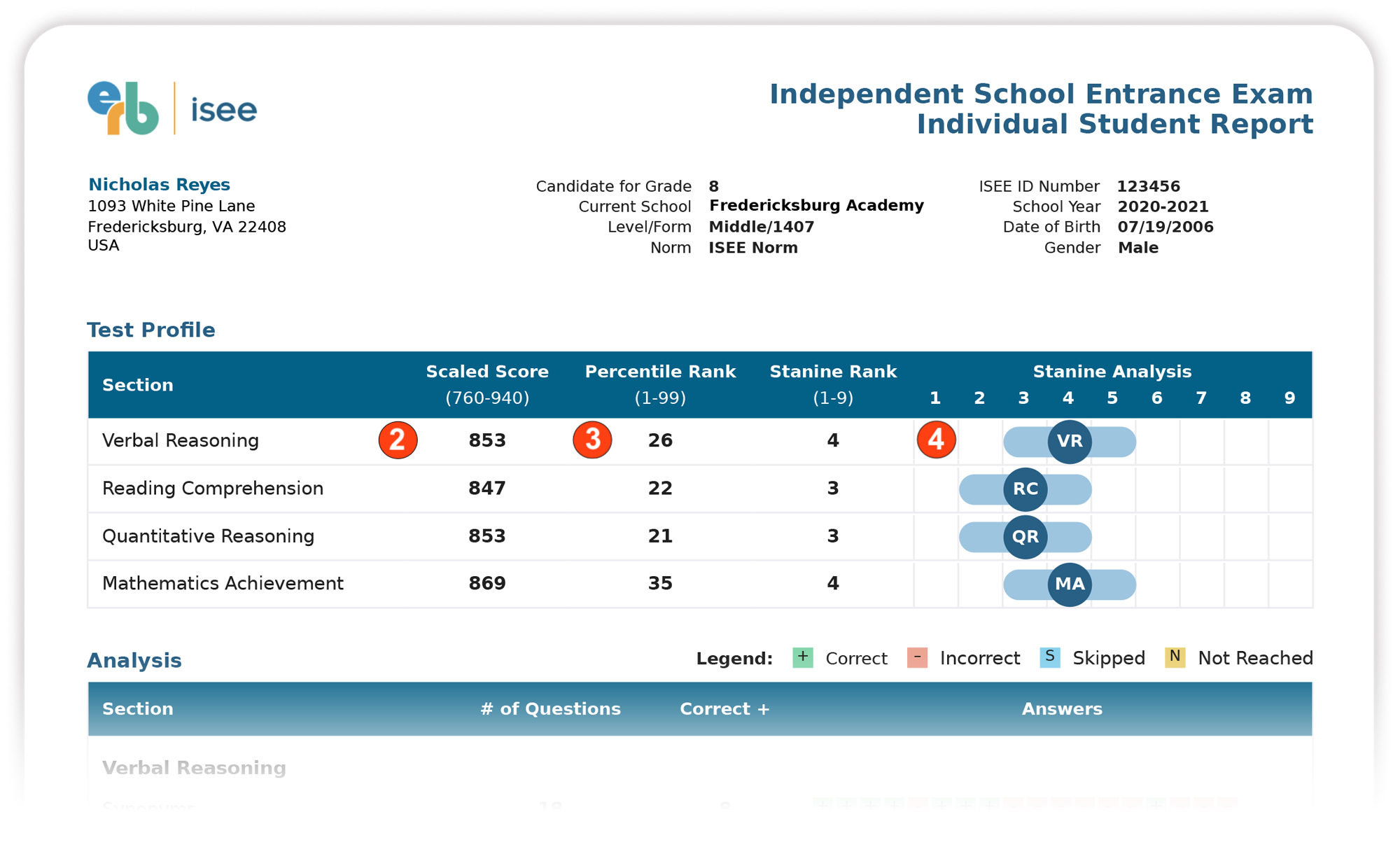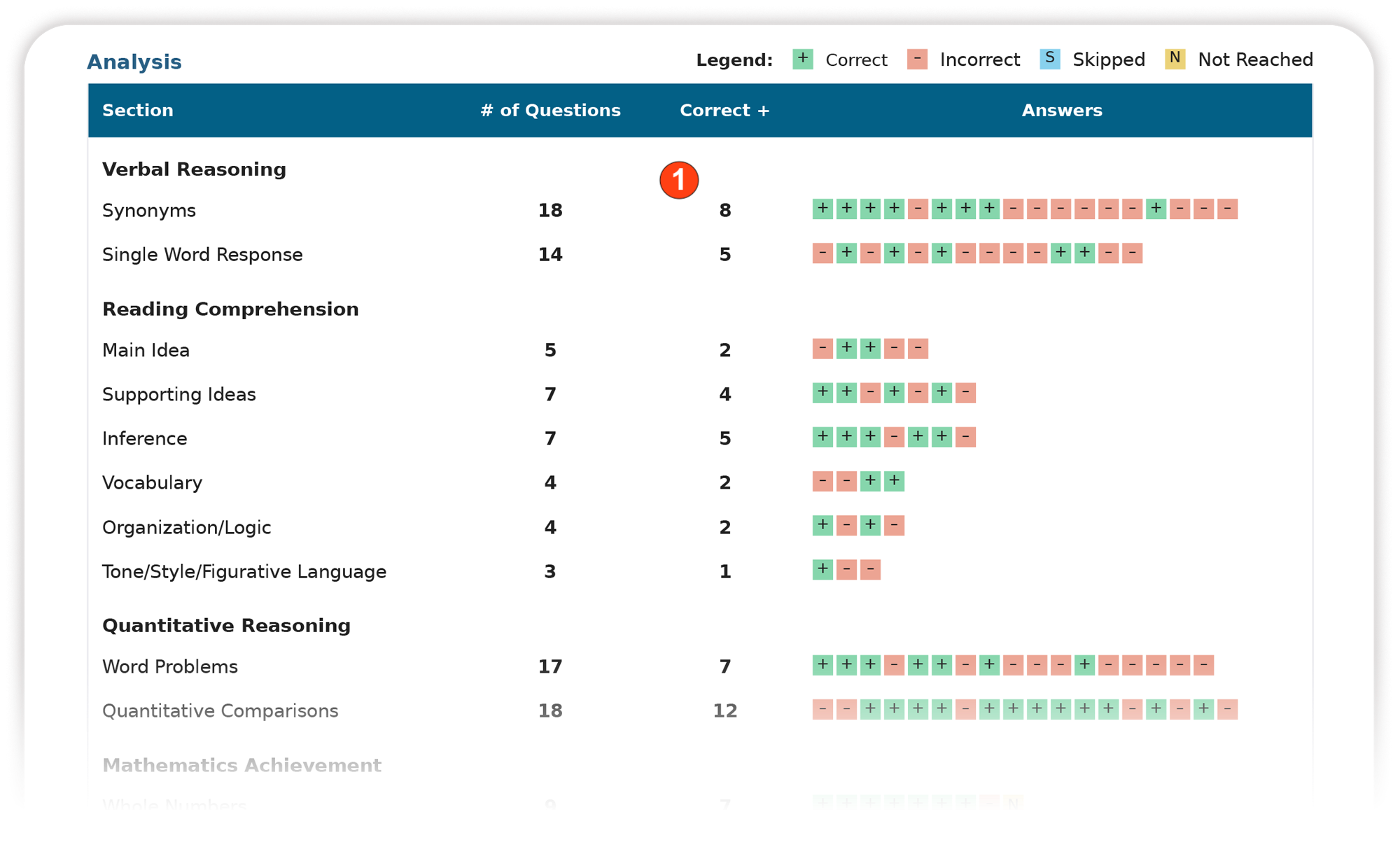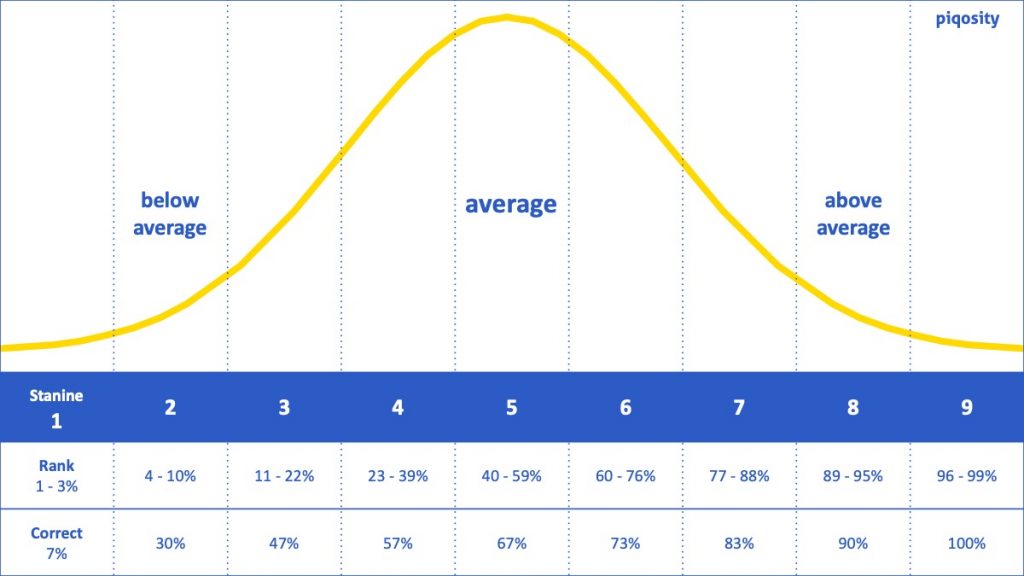Whether you’ve just started preparing to take your first ISEE, or are anxiously waiting to receive your score report, you’re probably wondering: what is a good score on the ISEE?
In general, a good ISEE score is a Stanine Score of 7, 8, or 9. Stanine Scores of 4, 5, and 6 are considered average, and scores of 1, 2, and 3 are below average. However, the comprehensive answer to this question depends on several factors, including the schools to which you are applying.
Additionally, the ISEE doesn’t measure your results with just Stanine Scores (short for “standard nine”). In fact, when you get your score report, you will see 4 types of scores. If you are confused about all the different types of scores the ISEE provides, don’t worry. Piqosity’s guide to what is a good score on the ISEE can help.
Preparing for the ISEE? Check out Piqosity’s articles on What to Expect on the ISEE Upper Level Test, What to Expect on the ISEE Middle Level Test, and What to Expect on the ISEE Lower Level Test.
What is the ISEE?
Before getting into the nitty gritty of how to understand what is a good score on the ISEE, let’s briefly review the purpose of the ISEE and why students choose to take this test. (Already familiar with the ISEE? Jump to our explanation of ISEE test scores.)
The Independent School Entrance Exam (ISEE) is a popular admissions test taken by American students applying to private middle and high schools, comparable to the way the SAT and ACT are taken by applicants to colleges and universities. The ISEE is developed and marketed by the Educational Records Bureau (ERB).
There are three levels of the ISEE: Lower Level (Applicants to 5th and 6th grade), Middle Level (Applicants to 7th and 8th grade), and Upper Level (Applicants to 9th-12th grade). The structure of each test is the same, but time limitations and test difficulty vary depending on the level of the test.
All levels of the ISEE comprise four separately scored subject tests and one non-scored essay:
For an overview of the ISEE’s schedule, test format, and more, check out the following video. Although some of the information is specific to the Upper Level ISEE, much is applicable to all levels of the test.
How Do You Read ISEE Scores?
The ISEE, like most standardized tests, is a peer-normed test, which means that students are scored relative to each other. Specifically, you will be scored relative to all students at your grade level who have taken the ISEE over the last three years. This is called the Norm Group. It does not include students in your grade for the year you take the ISEE.
After your exam has been scored, you will receive a score report that looks something like this excerpt below:

Every section except the ISEE Essay receives four scores:
- Raw Score
- Scaled Score
- Percentile Rank
- Stanine Score
Taken together, these scores provide a deep picture of your (or your child’s) performance. Let’s break down what each score indicates and how they are related to one another.
Raw Score
The Raw Score is the number of questions you answered correctly:
- no deductions for incorrect answers on the ISEE;
- no points are earned or deducted for skipped questions.
Therefore, it is in your best interest to have an answer filled in for all questions on the ISEE. It is important to note that no matter how you fare on your ISEE, you cannot fail the test.
There are many versions of the ISEE in circulation to prevent students in the same room from easily cheating off of each other. The version of the ISEE you take will be different from the version of the ISEE the student sitting next to you is taking. Therefore, the Raw Score does not mean the same thing across all versions of the ISEE.
Scaled Score
Because the Raw Score differs from test to test, the ERB converts your Raw Score into a Scaled Score, ranging from 760 to 940. These Scaled Scores mean the same thing across all versions of the ISEE. They are used to compare you against the norm group and determine your Percentile Rank and Stanine Score.
Percentile Rank
Your ISEE Percentile Rank represents how well you did in comparison to the norm group. Scoring a 30th Percentile Rank means you scored better than 30% of the Norm Group; scoring a 95th Percentile Rank means you scored better than 95% of the Norm Group.
It’s important to remember that the Norm Group is largely composed of high-achieving students who are applying to competitive schools just like you; when taking the ISEE for the first time, many students score in a lower Percentile Rank than they are accustomed to.
Stanine Score
Finally, your Stanine Score shows where your results fall on a normal bell curve. Results from the entire norm group are plotted along a normal bell curve (illustrated below). Those results are further subdivided into nine intervals, each of which represents 0.5 standard deviation (except the first and last brackets, which are the remainders).
In the graphic above, note that Stanine scores of 4, 5, and 6 represent the bulk of the norm group, or average performance, while scores of 7, 8, and 9 represent exceptional scores.
Putting It All Together
To review the numbers from your ISEE Individual Student Report:
- Raw Score tells you how many ISEE test questions you answered correctly
- Scaled Score is your raw score converted so that it can be compared to the scores of students who took a different but comparable ISEE
- Percentile Rank shows how your Scaled Score measures up to your peer’s scores from the past three years
- Stanine Score places your Percentile Rank into 1 of 9 groups.
How many questions can you miss and still get a good score?
Since we said that a “good score” ranges from a stanine of 6-9, we see from the tables below how many questions a student can miss per section and achieve that outcome. These numbers are based on the data we have from Fall 2023 and are for demonstrative purposes only; remember that the actual number of questions you must get correct to attain a certain percentile rank or Stanine Score varies from year to year—and even test to test.
ISEE Lower Level Questions Missed Analysis 2023-24
| Section | # Questions Missed for a 6 | # Questions Missed for a 7 | # Questions Missed for an 8 | # Questions Missed for a 9 |
|---|---|---|---|---|
| Verbal Reasoning | 6–7 | 4–5 | 2–3 | 0–1 |
| Reading Comprehension | 5–6 | 3–4 | 2 | 0–1 |
| Quantitative Reasoning | 7–9 | 4–6 | 2–3 | 0–1 |
| Mathematics Achievement | 3–5 | 2 | 1 | 0 |
ISEE Upper Level Questions Missed Analysis 2023-24
| Section | # Questions Missed for a 6 | # Questions Missed for a 7 | # Questions Missed for an 8 | # Questions Missed for a 9 |
|---|---|---|---|---|
| Verbal Reasoning | 11–13 | 7–10 | 5–6 | 0–4 |
| Reading Comprehension | 4–6 | 3 | 2 | 0–1 |
| Quantitative Reasoning | 9–12 | 6–8 | 3–5 | 0–2 |
| Mathematics Achievement | 14–17 | 9–13 | 5–8 | 0–4 |
Which ISEE Score Do Schools Pay Attention To The Most?
When you hear other parents, students, and teachers discussing what is a good score on the ISEE, they are usually talking about their Stanine Scores. The Stanine Scores are also what schools usually care most about most, as they provide the most succinct way of measuring a student’s performance on the ISEE test. Again, Stanine Scores range from 1 to 9; 1 is the worst score, and 9 is the best score that you can have when applying to private schools.
- Stanine Scores of 7, 8, and 9 are the highest and represent the top 25% of test-takers and are preferable for competitive, academically rigorous schools with more applicants than spaces available.
- Stanine Scores of 4, 5, and 6 are average and represent the middle 50% of test-takers and are generally acceptable for less competitive schools which might not prize academics above all else.
- Stanine Scores of 1, 2, and 3 represent the bottom 25% of test-takers and are generally not acceptable for admission to private schools.
If you’re applying to famous boarding schools or academically competitive academies in major metropolitan areas like Exeter (NH), Dalton (NYC), Harvard-Westlake (LA), or St. John’s (Houston), your ISEE goal score should absolutely be a 7, 8, or 9. But if you’re applying to less well-known schools or live in a smaller community, you will likely be a fine candidate with average scores of 4, 5, and 6.
In other words, when you begin looking at the schools to which students wish to apply, the answers to the questions “What is a good score on the ISEE?” and “What is a bad ISEE score?” really become subjective.
Scoring The ISEE Essay
As you will remember, the fifth and final section of the ISEE is the personal essay, which is not scored. Copies of your essay are sent directly to schools for their review, so make the most of this opportunity to make a good impression on school admissions counselors.
The ISEE essay prompts usually ask you to reflect on a personal experience or discuss your actions in a hypothetical scenario. The school admissions counselors who read your essay will certainly be evaluating your skills as a writer, but they are also looking to learn something about you as an individual.
Learn how to demonstrate your excellent writing abilities and give your reader a sense of your personality with Piqosity’s guide to How to Write a Good ISEE Essay.
How and When To Start Preparing for the ISEE
When it comes to when you should start ISEE prepping, it mainly depends on when you’ll take the test and how much free time you have for studying. Most students will take the ISEE in late winter or early spring. As such, about a quarter of students will start preparing for the ISEE the summer before they plan to take the test, half will start in fall, and the remaining quarter will wait until the last minute in winter or early spring.
Now that you know what is a good score on the ISEE, it’s time to get studying! Taking a standardized test like the ISEE is a skill, and as with all skills, practice makes perfect. The more effort you spend preparing for the ISEE, the more likely you are to see your scores improve. Piqosity offers a wide range of ISEE test prep materials, perfect for both tutored and self-guided ISEE practice, including:
- 10 full-length ISEE practice tests (for the Lower, Middle, and Upper Levels)
- Over 3,000 practice questions (equivalent to 20 tests’ worth)
- Over 50 concept lessons, including tutorial videos
- Real-time Stanine Score predictions and Adaptive Practice
- Interactive interface allowing teachers, tutors, or parents to assign and track student work
- …And much more!
If you’re at all interested in studying for the ISEE, we encourage you to take our mini diagnostic ISEE online practice test, available for free after registration with our Community Plan. When you’re ready to upgrade, Piqosity’s year-long accounts start at only $89.




Im gonna take this test soon and idk how to prepare still for 7-8 and im getting rlly anxious that i wont pass! Any tips pls!
Hi Kayla!
I’m sorry to hear that you’re feeling anxious. Along with our ISEE courses, we have many free resources available to help you practice if you look at our ISEE blogs.
Since the test is coming up soon for you, I recommend this blog for some last minute ISEE tips.
Finally, if you’re still anxious, make sure to check this article out, too – these tips can help you manage any test-taking stress or nervousness.
Good luck!